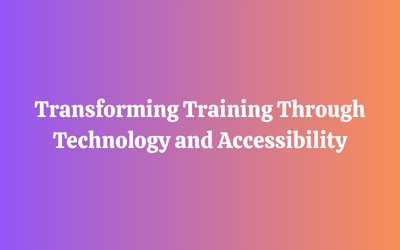What Is Agile Learning?
Agile learning, or agile instructional design, refers to any approach to training development that focuses on speed, flexibility, and collaboration.
Agile is a term usually associated with software development. Yet, additional business units have embraced agile methodologies to help them quickly pivot in response to market changes as company speed has increased. The process of creating learning experiences in the modern, digital age could greatly benefit from the agile methodology, according to L&D leaders. As such, agile learning was born.
Agile also embraces speed. As L&D leaders are continually challenged with rolling out highly complex training, the ability to rapidly develop and distribute a large volume of learning content is paramount.
This has had a significant impact on the field of instructional design.
Agile vs. ADDIE
Agile and ADDIE are the two main techniques used in instructional design.
The tried-and-true, conventional linear method of content development is called ADDIE. The five ADDIE steps—Analyze, Design, Develop, Implement, and Evaluate—all place a strong emphasis on receiving approvals at each stage. Academic designers who create fundamental information taught over a long period utilize ADDIE as the first framework because it ensures the accuracy and relevancy of content.
The instructional designers who create programs to certify engineers and technicians can also benefit from ADDIE. While creating programs to carry out crucial compliance training, is also helpful.
The speed of ADDIE is one of its drawbacks, though. In contrast, agile learning design is an interactive and iterative process that often puts speed before other considerations.
Leveraging Agile to design learning experiences
Agile can be used at any stage of the learning development process, but it is most effective when a project is being planned and developed. This comprises:
1- Consuming training
2- Project management
3- Collaboration
Agile offers the “failing fast” iterative mentality that accelerates pace without sacrificing quality as L&D teams aim to adapt more quickly to organizational needs from a training viewpoint.
Excellent for reuse of material and knowledge repositories
Agile learning design is helpful when training departments wish to make use of and repurpose current learning materials. Agile can be used by instructional designers to alter dozens or even hundreds of pre-existing PowerPoint presentations and course materials. Instructional designers can use agile, rapid development tools to edit, update, or convert content as necessary rather than starting from scratch with ADDIE.
With the advent of the internet, it has been easier to share information and collaborate with others. These learning materials might not always be comprehensive courses with lectures and tests, but rather briefer, more manageable knowledge that staff members can simply access as needed. Learning leaders can build such content using agile principles rather than a longer instructional design process like ADDIE.
Harmonious coexistence
For certain types of learning projects, in which the outputs include sophisticated curriculum or certification-based training, ADDIE may be the ideal approach to start. When all of the components of a multi-day or multi-week course or program need to be connected during the analysis phase, the agile instructional design would be challenging to implement.
Nonetheless, using both can be advantageous for some instructional designers. Many designers start with ADDIE for the analysis and design phases of longer-cycle development projects. The development, implementation, and evaluation phases are subsequently sped up by utilizing many of the concepts and methods of agile instructional design.
Agile instructional design is an excellent technique to control the entire process for performance support or on-the-job/moment-of-need requirements.
Learn More
Our News
- AI
- Animations
- Articulate
- Articulate 360
- Articulate Engage
- Articulate Live
- Articulate Presenter
- Articulate Quizmaker
- Articulate Replay
- Articulate Review
- Articulate Storyline
- Articulate Storyline 3
- Articulate Studio
- bite sized learning
- Characters
- Content Library
- Corporate Communication
- E-Learning
- e-Learning Authoring Tools
- Employee Engagement
- Game-Based Learning
- Gamification
- Gamiflexer
- Go Sales
- Healthcare
- Instructional Design
- Interactivity
- Knowledge Transfer
- L&D Trends
- Learning
- Learning & Development
- Learning Experience platform
- Learning Management System
- LMS
- LXP
- Microlearning
- mLearning
- Mobile Learning
- Nugget Learning
- Online Training
- Peek
- Performance Support
- Preso
- Quiz and Assessment Platform
- Replay 360
- Rise
- SCORM
- Screen Capture
- Software
- Storyline 360
- Studio 360
- Training Management
- Trainings
- Uncategorized




